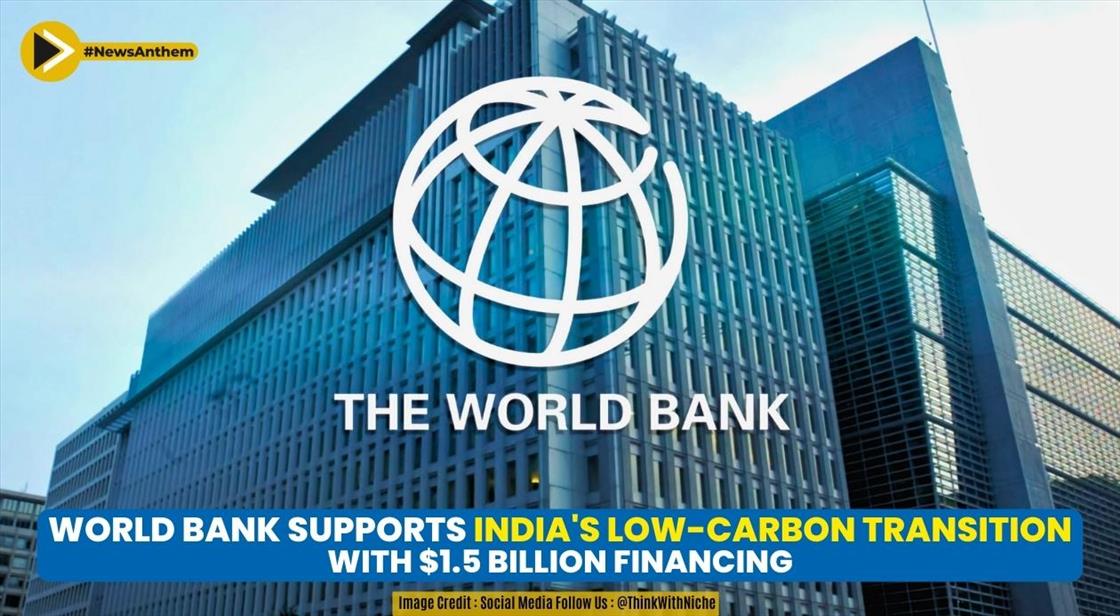World Bank Approves USD 1.5 Billion Financing for India's Low-Carbon Transition

News Synopsis
World Bank Commits $1.5 Billion to Boost India's Low-Carbon Transition
The World Bank has granted approval for $1.5 billion in financing to expedite India's shift towards a low-carbon energy infrastructure. This financial support aims to facilitate the promotion of renewable energy expansion and the advancement of green hydrogen technologies.
India, being one of the world's fastest-growing economies, is expected to experience a significant surge in energy demand as its economy continues to expand.
Accelerating the Transition to Low-Carbon Electricity
India, with its impressive progress in renewable energy capacity and cost reduction, is well-positioned to scale up the production of clean energy sources. The World Bank recognizes the potential of renewable energy in accelerating the transition to low-carbon electricity.
By leveraging renewable energy sources and supporting the development of the green hydrogen sector, India can achieve its ambitious goal of becoming net-zero by 2070.
World Bank's Commitment to Green Hydrogen Development
Reiterating its commitment to India's green hydrogen initiatives, the World Bank emphasizes the importance of this low-carbon energy source. Green hydrogen is produced through electrolysis powered by renewable energy, offering a sustainable solution to decarbonize industries, transportation, and the energy sector.
India's National Green Hydrogen Mission, which aims to position the country as a global hub for green hydrogen production, has received the World Bank's support.
Funding for a Sustainable Future
The financing from the World Bank will aid in the successful implementation of India's National Green Hydrogen Mission, which is expected to attract $100 billion in private sector investment by 2030.
This substantial financial backing will contribute to the research and development activities necessary for the mission's objectives. Additionally, the funding will support the establishment of a national carbon market, creating a level playing field between low-carbon energy and fossil fuels.
India's Commitment to a Sustainable Path
During the COP26 summit in Glasgow, India pledged to achieve several ambitious targets as part of its "Panchamrit" pledge. These commitments include reaching 500 GW of non-fossil electricity capacity, generating half of its energy from renewable sources, reducing emissions by 1 billion tons by 2030, and reducing the emissions intensity of GDP by 45 percent. Ultimately, India aspires to achieve net-zero emissions by 2070.
The World Bank's financing will complement public investments and encourage private sector participation, supporting India's journey towards a low-carbon future.
By promoting renewable energy, green hydrogen, and the establishment of a national carbon market, India is paving the way for sustainable economic growth and a greener, cleaner environment.
Important Facts:
-
The World Bank has approved USD 1.5 billion in financing to accelerate India's low-carbon energy infrastructure.
-
The financing will support India's National Green Hydrogen Mission, which aims to make India a global hub for the production, utilization, and export of green hydrogen.
-
Green hydrogen is a low-carbon hydrogen energy produced by electrolysis of water powered by renewable energy.
-
India in early January approved the National Green Hydrogen Mission, aiming to make the country a global hub for the production, utilization, and export of such technologies.
-
The initial financial outlay for the mission is pegged at Rs 19,744 crore, which includes research and development activities.
-
The green hydrogen mission will gradually lead to the decarbonization of the industrial, transport, and energy sectors.
-
Under this mission, the government aims to raise annual green hydrogen production to 5 million tonnes, and renewable energy capacity addition of about 125 gigawatts.
-
India has committed to achieving net zero emissions by 2070.
-
India has achieved impressive progress in renewable energy, with installed capacity reaching 100 GW in 2022.
-
The World Bank remains committed to supporting India's low-carbon transition by complementing public financing and enabling private sector investments.
Conclusion
The World Bank's approval of $1.5 billion in financing marks a significant step towards India's low-carbon transition. The funding will enable India to accelerate the development of renewable energy infrastructure and green hydrogen technologies, supporting its ambitious goals of achieving net-zero emissions by 2070 and becoming a global hub for clean technologies.
The World Bank's commitment to supporting India's low-carbon transition demonstrates the importance of international collaboration in addressing climate change and promoting sustainable economic growth.
With this financial backing, India is well-positioned to scale up its renewable energy capacity, reduce greenhouse gas emissions, and establish a thriving green economy.
Through strategic investments and the implementation of innovative policies, India is taking proactive steps towards a greener, more sustainable future.
You May Like









